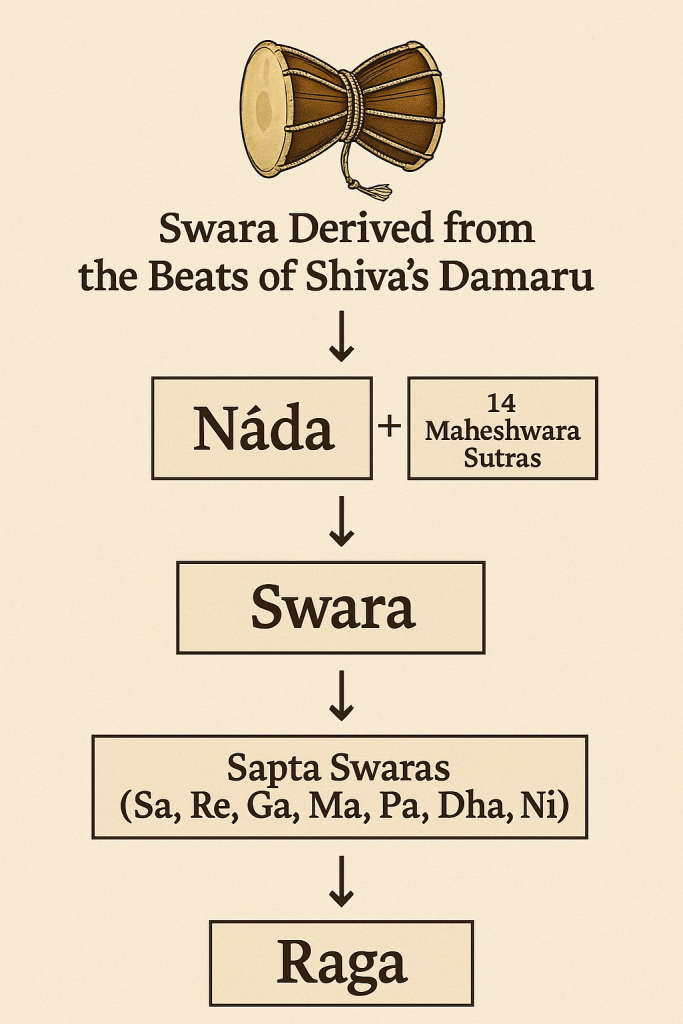The 14 Nada-s and the Eternal Sound Within
“When Śhiva danced the Tāṇḍava, the universe itself began to sing.”
In the silence before creation, there was vibration Nāda.
And from the ḍamaru of Lord Śhiva came fourteen pulses the Māheśvara Sūtrāṇi which became the blueprint of both language and music, the very architecture of sound.
🕉️ The 14 Mahesvara Sutrani (महेश्वरसूत्राणि)
As recorded in Pāṇini’s Aṣṭādhyāyī (I.3.2–3), these fourteen sound clusters were heard when Śhiva’s ḍamaru beat during his cosmic dance. They encode every phoneme of Sanskrit the language of vibration.
- अ इ उ ण् (a i u ṇ)
- ऋ ऌ क् (ṛ ḷ k)
- ए ओ ङ् (e o ṅ)
- ऐ औ च् (ai au c)
- ह य व र ट् (ha ya va ra ṭ)
- ल ण् (la ṇ)
- ञ म ङ ण न म् (ñ m ṅ ṇ n m)
- झ भ ञ् (jha bha ñ)
- घ ढ ध ष् (gha ḍha dha ṣ)
- ज ब ग ड द श् (ja ba ga ḍa da ś)
- ख फ छ ठ थ च ट त व् (kha pha cha ṭha tha ca ṭa ta v)
- क प य् (ka pa y)
- श ष स र् (śa ṣa sa r)
- ह ल् (ha l)
Sources: Pāṇini – Aṣṭādhyāyī I.3.2–3; Śaiva commentaries such as Kāśikā Vṛtti; see also Ramanis Blog (2015) and The Matheson Trust Library.
Ahata and Anahata The Two Dimensions of Sound
In the language of the sages, sound exists in two states the Āhata Nāda and the Anāhata Nāda.
Āhata Nāda is the struck sound the vibration born of contact, the audible world of strings, drums, voices, and all physical resonance.
It is what we play, hear, and measure the realm where music lives as wave and frequency.
Anāhata Nāda is the unstruck sound the inner pulse of consciousness that vibrates without any physical source.
It is the sound of silence, the eternal drone of awareness that every raga seeks to awaken.
Together they form the complete spectrum of listening:
one heard by the ear, the other by the heart.
When both merge, music transcends performance it becomes meditation.
From Nada → Swara → Raga
The unstruck sound (Anāhata Nāda) gives rise to audible vibration (Āhata Nāda).
From that vibration, seven frequencies emerge Sa Re Ga Ma Pa Dha Ni each mirroring a principle of nature, an emotion, a planet, a pulse.
“When sound awakens to consciousness, melody is born. When consciousness moves through rhythm, life begins to dance.”
The Sound Before Birth – The Rhythm Within
Before you ever saw light, you heard sound.
Inside your mother’s womb, you floated in rhythm heartbeat, breath, the oceanic hush of life.
That was your first rāga your initiation into rhythm long before language.
No wonder rhythm connects us more deeply than melody, for rhythm is the melody of existence.
The ancients knew that the human body is a resonant instrument of the universe:
- The heartbeat aligns with rhythm (Laya).
- The breath oscillates like Tāla.
- The brain-waves pulse in tempo like the drone of a tanpura.
Even the water level in our body (≈ 71%) mirrors the Earth’s surface water % reminding us that the microcosm and macrocosm sing in perfect synchrony.
We are, quite literally, the music of the cosmos made flesh.
Sthula and Suksma Deha The Visible and Invisible Bodies
Ancient Indian philosophy speaks of two primary forms of our existence:
Sthūla Deha – the physical body you can see and touch, and
Sūkṣma Deha – the subtle or energetic body that you cannot see but can feel.
The Sthūla Deha (gross body) is made of the five great elements Earth, Water, Fire, Air, and Space.
It connects us to the visible world to gravity, nutrition, rhythm, and movement the same elements that compose our planet itself.
The Sūkṣma Deha (subtle body) is woven of vibration thought, emotion, prāṇa (life energy), and nāda (sound).
It cannot be seen by the eye, yet it shapes how we feel, how we resonate, and how we express music or consciousness.
Together they form a mirror of the universe: the Sthūla as the outer shell,and the Sūkṣma as the inner frequency.
Both exist in constant dialogue through sound, rhythm, and awareness.
“यथा पिण्डे तथा ब्रह्माण्डे As is the atom, so is the cosmos.”
When we sing a svara or experience a rāga, both bodies participate: the Sthūla Deha vibrates through the air and breath, while the Sūkṣma Deha resonates through feeling and consciousness. Sound thus becomes the meeting point between the visible and the invisiblebetween matter and spirit, between human and cosmos.
The Science of Vibration Ancient and Modern
Modern physics speaks of string theory and wave-particle duality; the ancients called it Śabda Brahman the universe made of vibrating consciousness. Where scientists describe oscillations of energy, the sages experienced Nāda directly not as abstraction but as awareness.
Both paths meet: one through observation, the other through meditation each arriving at the truth that sound is the bridge between matter and spirit.
Closing Reflection
डमरूः स्पन्दितः सप्तद्वीपस्स्वरसंहारिणः ।
अलङ्कृतानां वाणीर्मध्यं चेतसि स्थितम् ॥“The drum of Śhiva pulsates across the seven lands of sound;
the voice of beauty rests in the heart’s centre.”
Every rhythm you feel, every melody you play, every beat you craft is not merely music; it is the memory of creation itself.
The 14 Nāda-s, the seven Swaras, and the countless Rāgas are all variations of one truth: the universe is sound, and we are its echo.
Sanskrit References From
- Pāṇini Aṣṭādhyāyī I.3.2–3, canonical source of Māheśvara Sūtrāṇi
- Śārṅgadeva Saṅgīta Ratnākara (c. 13 CE), connecting Nāda to music theory
- Nāṭya Śāstra of Bharata Muni linking sound, emotion, and rasa
- Ramanis Blog (2015): “Sanskrit from Śiva’s ḍamaru”
- The Matheson Trust: “Śiva Sūtras” Library Edition
- Aesthetics of Society (2019): “The 14 Śabdas of Śiva’s ḍamaru”




